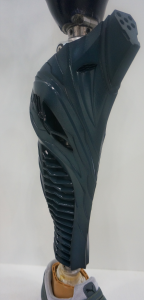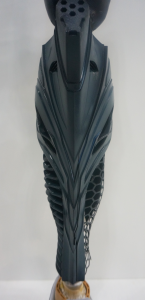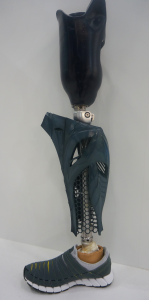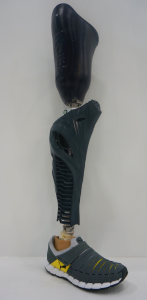Ω
Surely amputees and those in need of prosthetics never dreamed they would see the day when such devices would become trendy, cool, and so incredibly customized, thanks to the technology of 3D printing. From all ages competing in athletic events to kids sporting 3D printed super-hero style prosthetic arms, not only has the world of prosthetics become one that offers a higher quality product at a lower price with  incredible customization, but it is, quite simply, more lighthearted–and full of inspiration.
incredible customization, but it is, quite simply, more lighthearted–and full of inspiration.
Celebrating the human body and all its challenges, the 3D printed prosthetic has also often presented itself as a work of art, functioning not only as a utilitarian device but also as a thing of beauty, uplifting the individuals who receive them.
Now, Taketo Kobayashi (collaborating with designer Yoshinori Sakamaki) is taking 3D printed prosthetic legs to the next level with the XSENSE brand, elevating his devices with such Japanese genres as anime, and even allowing his work to serve as an abstract expression of Japanese subculture. With the underlying theme being that of larger-than-life, extremely capable robots, Kobayashi is able to imbue his prosthetics with not only aesthetics, but strength.
“Robots appear in manga and anime not just as mechanics, but also as vessels which contain power greater than that of humans, just the same as people of Jomon had believed in the greater power of nature,” Kobayashi told 3DPrint.com. “I am using modern technology, but my soul belongs to animism, making a circle connecting the ancient, modern, and future.”
While the actual prosthetic leg and shoe are an existing product, the cover on the shin is completely 3D printed, and arrives in two parts for easy attachment.
MTH and XSENSE is a collaborative project using 3D printing and projection mapping to blur the lines between art and technology, as well as old, new, and different cultures. They enjoy using art to “make a better, more peaceful world, through creating a new post-modern identity of ourselves.”
Kobayashi recently explained his design process to 3DPrint.com, regarding his line of prosthetics.
“Mixing novelty and user-friendliness is the theme behind such prosthetic parts as my unicorn design,” said Kobayashi. “It can easily attach to existing prosthetics, and does not have sharp parts, which can be an obstacle for walking.”
Working with Canon Marketing in Japan for the unicorn design, the design process takes him about two weeks, with the prosthetics being fabricated on a ProX 500 by 3D Systems. Using nylon resin, it took around 18 hours of 3D printing to complete the project.
In post-processing, the artists use dye to finish the artwork. In this case, they used both dye and a clear urethane topcoat.
“I believe 3D printed products should acquire their own value from the material view,” Kobayashi told 3DPrint.com. “Most people try to finish the 3D printed product like an existing industrial product, but from the artistic point of view, the material of the 3D printed product is unique as it printed. We just have to find the way to emphasize its uniqueness. When I dye nylon 3D printed artwork layers, it looks like tree rings, and is really beautiful.”
The artists are still in the design and production phase with their prosthetics, but are hoping to show their work off at Paralympic Tokyo 2020.
“We have not tried to fit this model to people yet, but we will be modeling the designs with a couple of Japanese paralympians,” said Kobayashi. “The next step is to try it on them and take promotional photographs. We are hoping many paralympians will wear our artwork at Paralympic Tokyo 2020.”
Discuss your thoughts on these latest prosthetics in the 3D Printed XSENSE Prosthetics forum thread over at 3DPB.com.
Subscribe to Our Email Newsletter
Stay up-to-date on all the latest news from the 3D printing industry and receive information and offers from third party vendors.
You May Also Like
Gorilla Sports GE’s First 3D Printed Titanium Cast
How do you help a gorilla with a broken arm? Sounds like the start of a bad joke a zookeeper might tell, but it’s an actual dilemma recently faced by...
Nylon 3D Printed Parts Made More Functional with Coatings & Colors
Parts 3D printed from polyamide (PA, Nylon) 12 using powder bed fusion (PBF) are a mainstay in the additive manufacturing (AM) industry. While post-finishing processes have improved the porosity of...
$25M to Back Sintavia’s Largest Expansion of Metal 3D Printing Capacity Since 2019
Sintavia, the digital manufacturing company specializing in mission-critical parts for strategic sectors, announced a $25 million investment to increase its production capacity, the largest expansion to its operations since 2019....
Velo3D Initiates Public Offering in a Bid to Strengthen Financial Foundations and Drive Future Growth
Velo3D (NYSE: VLD) has been among a number of publicly traded 3D printing firms that have attempted to weather the current macroeconomic climate. After posting a challenging financial report for 2023,...






































